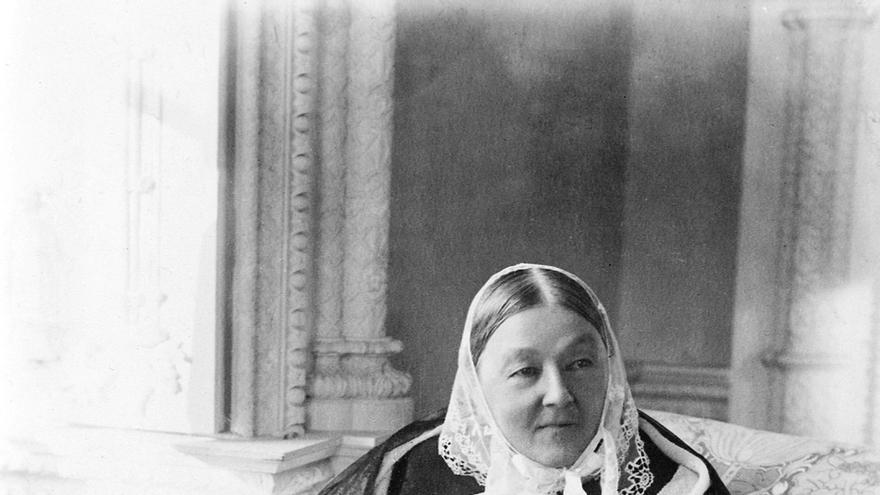He international nursing day It is celebrated every May 12. Because? Because on that day, in 1820, Florence Nightingale was born into a wealthy British family. What fate did she await her? Toiling in her education in order to get a good marriage with someone of her social class.
But Florence had other planes. In 1837 she announced to her family her desire to dedicate herself to nursing, a profession that at that time was associated with working-class women. Nothing to do with a cultured young woman like Florence! As if that were not enough, in 1840, she begged her parents «to let her study mathematics instead of repetitive work and quadrat practice.»
Despite initial family opposition, Nightingale managed to train in both disciplines. He learned arithmetic, geometry, and algebra from tutors such as mathematician James Joseph Sylvester. And she became a self-taught nursing expert, frequenting the health centers that she visited on each of her trips.
In August 1853 he took up the post of superintendent at the Institute for the Care of Sick Ladies (homeless women) in London. Some improvements were made there, such as the installation of hot water in the rooms and the placement of an elevator.
Between October 1853 and February 1856, the Crimean War took place, a conflict between the Russian Empire and an alliance made up of the United Kingdom, France, the Ottoman Empire, and the Kingdom of Piedmont and Sardinia. British troops were mobilized to fight in the Crimea against the tsarist government’s policy of aggression against Turkey.
Although the Allies were winning on the battlefield, disease was decimating the British army. In the first weeks of the conflict, 80% of those who died in field hospitals were victims of deficient health care. The then British Secretary for War and longtime acquaintance of the Nightingale family, Sidney Herbert, asked Florence for help.
On October 21, 1854, Nightingale and her team of thirty-eight volunteer nurses set out for the front. They were transported across the Black Sea to Britain’s base of operations at Scutari. They arrived there at the beginning of November 1854.
The panorama they found in the hospital was bleak: the soldiers received inadequate treatment by a medical team overwhelmed by the situation, while the army commanders did not react. Medical supplies were in short supply, hygiene was pitiful, infections were rife, food was insufficient and poorly treated.
Under these conditions, soldiers died from diseases such as typhus, typhoid fever, cholera and dysentery. Those deaths far outnumbered those due to injuries sustained on the battlefield.
Florence requested health aid from the British government and, after receiving it, surely the cleaning of polluting dumps and improved ventilation in the hospital. With these measures the death rate dropped rapidly.
The days passed and Florence walked around with her lamp, every night, taking care of and observing the patients, noting their evolution and collecting data.
A Graphics Pioneer
After the war, Nightingale devoted himself to ordering his detailed notes and collecting statistics on mortality in the military hospital. To convince the authorities of his conclusions, he used a graphical system instead of presenting his numbers in a tedious and unintelligible list.
idea the call rose diagram who managed, directly and intuitively, to convince the British Government of the need to carry out drastic hygiene reforms in hospitals.
The rose diagram includes an explanation in its lower left corner:
Each of the blue and red areas and the black sections are measured using the center as the common vertex.
The blue sections measured from the center of the circle represent, area by area, deaths from infectious diseases, from predictable to mitigable. The red sections measured from the center represent deaths from injuries. The black sections measured from the center represent deaths from other causes.
The black line that crosses the red triangle in November 1854 marks the limit of deaths due to all other causes during that month. In October 1854 and April 1855, the black area coincided with the red. In January and February 1855, blue coincided with black.
Entire areas can be compared by following the blue, red, and black boundary lines.
As can be seen, in this diagram three variables are represented: time (each sector is a month), the number of deaths (the area of the sector) and the cause of death (color). It was a novel system at a time when the usual statistical charts were bar and pie charts, representing only one or two variables.
The rose diagram shows that, after the hygiene measures taken by Florence, the proportion of deaths from disease (the blue sectors) gradually decreased. She provided a visual and quick way to convince the authorities of the changes that they urgently undertake. Without a doubt, Florence Nightingale saved many people’s lives.
The year 2010 was declared International Nursing Year to revive, among others, the historical relevance of Florence Nightingale on the centenary of her death.
Related news
This article is a compendium of articles Florence Nightingale, statistical pioneer and Florence Nightingale, much more than the lady with the lamp from the blog women with sciencepublication of the Chair of Scientific Culture of the UPV/EHU.
This article was originally published on The conversation. read the original.

